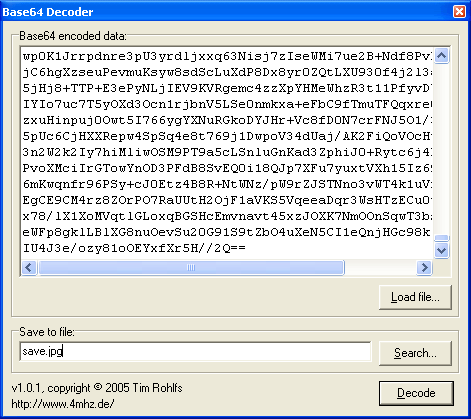

When you visit a website, your computer sends a request to the web server. To start, let's discuss how binary data is typically transmitted over a website. For that data to be transferred, it needs to be represented in a way that the computer can process. In the computer world, communication happens in binary (0's and 1's), but people typically communicate in much more complex forms of data, such as images, GIFs, and text. In these cases, Base64 encoded strings may be necessary since they always use only 26 letters from the English alphabet and ten digits from the Arabic numerals (0-9). For example, some operating systems limit filenames to 8 characters with no spaces or special characters.

It is also often used when there are limitations on the characters that can be used in a filename for various reasons. It's primarily used to store or transfer images, audio files, and other media online. What is Base64 encoding?īase64 encoding is a way to encode binary data in ASCII text. To understand this, it is necessary to know the basics about Base64. And indeed, today, there are a few nuanced reasons why Base64 should still be used. Most of the limitations that were solved by Base64 encoding have been bypassed. Since then, web browsers have become incredibly efficient at transferring a vast number of files over a single connection. This eliminated the need for an additional round trip that the browser required for each of the files. With Base64, this problem could be circumvented by using an already open HTTP connection to deliver images embedded directly in HTML or CSS. Therefore, a very image-heavy website had to join a queue of requests and wait until the previous ones had finished. Web browsers used strict limits on the number of simultaneous connections they could send to the server. This article explains why the suggestion to encode in Base64 and include it directly in your HTML needs to be differentiated and is long outdated in most cases. This is a common technique for compressing and transmitting data, as it takes less space than plain text and can be used in different contexts.

Make a GET reequest for the image and then read the response body into a slice ofīytes.Do you want to optimize your images and website performance? Looking for help these days, you still come across blogs that suggest image Base64 encoding. Isn’t much different from what we’ve already seen above. Remote imagesĬonverting an image that resides at a URL to its base64 encoding It should display the entire image as shown below. You can copy the base64 string and paste it directly to your browser’s addressīar. Standard output provided file.png exists on the filesystem. Once you run this code, it will print the base64 encoding of the image to the The result of this function call is appended to Which uses the () method to retrieve theīase64 encoding of the image. Afterwards, the toBase64() function is invoked Next, the http.DetectContentType() is used to determineįile so that the appropriate data URI scheme header is prepended to The first step is to read the image file into a slice of bytes through

#BASE64 DECODE IMAGE FULL#
Package main import ( "encoding/base64" "fmt" "io/ioutil" "log" "net/http" ) func toBase64 ( b byte ) string // Append the base64 encoded outputīase64Encoding += toBase64 ( bytes ) // Print the full base64 representation of the image


 0 kommentar(er)
0 kommentar(er)
